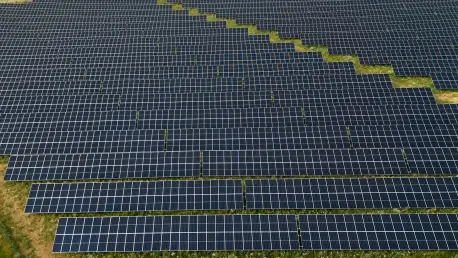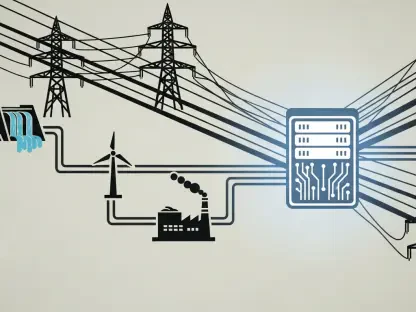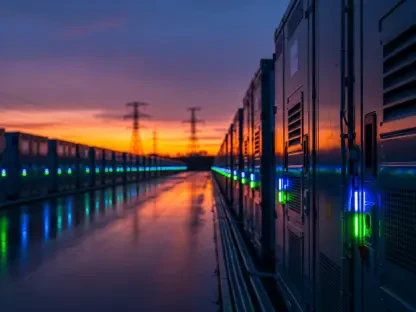Artificial Intelligence stands at the forefront of a technological revolution, reshaping the global landscape with its profound influence on both economic growth and energy infrastructure. As of October 2025, the rapid integration of AI across various sectors is not only driving unprecedented productivity gains but also placing immense pressure on power grids worldwide. This dual nature of AI—acting as a catalyst for economic transformation while simultaneously straining energy resources—presents a complex challenge that demands careful navigation. On one hand, the technology promises to inject trillions into the global economy by automating tasks and fostering innovation; on the other, its voracious appetite for electricity threatens to undermine sustainability goals. The tension between these two forces highlights a critical juncture where strategic solutions must emerge to balance progress with responsibility. This exploration delves into how AI is redefining industries, the environmental hurdles it poses, and the innovative ways it can help modernize the very systems it burdens. By examining these interconnected dimensions, a clearer picture emerges of the opportunities and obstacles that lie ahead in harnessing AI’s full potential.
Economic Powerhouse with Hidden Costs
The transformative potential of AI in the economic sphere is often likened to historic innovations such as electricity or the internet, marking it as a cornerstone of modern progress. Forecasts indicate that AI could contribute as much as $15.7 trillion to global GDP by 2030, driven by automation of repetitive tasks, enhanced productivity, and the creation of entirely new business models. Sectors like manufacturing, healthcare, and finance are already witnessing significant shifts, with AI streamlining operations, cutting costs, and sparking innovation in areas like personalized medicine and predictive analytics. This economic surge positions AI as a vital engine for growth, promising to redefine how industries operate on a global scale. However, the benefits are not without their complexities, as the technology’s rapid adoption raises questions about its broader impact on labor markets and economic equity.
Beneath the surface of this economic boon lies a more troubling reality that cannot be ignored. Up to 40% of jobs worldwide face exposure to automation, with routine and repetitive roles most at risk of being replaced by AI systems. This shift could exacerbate wealth inequality, particularly as the gains from AI are often concentrated in advanced economies and among major tech corporations with the resources to dominate the field. The disparity creates a pressing need for proactive measures, such as reskilling programs and policy frameworks, to ensure that the workforce can adapt to emerging roles in AI development and data management. Addressing these challenges is essential to prevent a widening gap between those who benefit from AI’s rise and those left behind, ensuring that economic progress remains inclusive and sustainable over the long term.
Energy Hunger Threatening Sustainability
While AI propels economic advancements, its immense energy demands pose a significant threat to environmental sustainability and global climate goals. Training large language models and other sophisticated AI systems consumes electricity on a scale comparable to the annual usage of hundreds of households, with a single model’s training phase often generating substantial carbon emissions. Projections suggest that by 2035, data centers powering AI operations could account for up to 20% of global electricity consumption, a staggering figure that underscores the urgency of addressing this issue. This energy intensity directly conflicts with efforts to reduce greenhouse gas emissions, placing AI at odds with international commitments to combat climate change. The scale of this challenge demands immediate attention to prevent it from derailing broader environmental objectives.
Compounding the electricity concern is the additional strain on resources like water, which is heavily utilized for cooling the vast data centers that support AI infrastructure. This dual environmental footprint—high energy use paired with significant water consumption—amplifies concerns about the technology’s long-term viability in a world increasingly focused on conservation. Without innovative solutions, the unchecked growth of AI could lead to a scenario where its benefits are overshadowed by ecological costs. The push for sustainable practices, such as developing energy-efficient algorithms and leveraging renewable power sources for data centers, has become a critical priority. Tackling these issues head-on is vital to ensure that AI’s expansion does not come at the expense of the planet’s health, balancing technological progress with environmental stewardship.
Modernizing Grids with a Double-Edged Sword
Amid the energy challenges posed by AI, the technology also emerges as a powerful tool for modernizing power grids, offering solutions to some of the very problems it creates. Through the development of “smart grids,” AI enhances energy distribution by optimizing flows, predicting demand fluctuations, and seamlessly integrating renewable sources like solar and wind into the system. These capabilities are crucial for transitioning to sustainable energy frameworks, especially as global reliance on clean power grows. Additionally, AI’s ability to enable predictive maintenance helps prevent outages by identifying potential issues before they escalate, a significant advantage for aging infrastructure struggling to keep pace with modern demands. This potential to revolutionize grid efficiency highlights AI’s role as a transformative force in energy management.
However, the irony remains that the same AI driving these advancements also places unprecedented stress on power grids through the soaring energy needs of data centers. Meeting this demand requires substantial investments in infrastructure upgrades, a costly endeavor that many regions are ill-equipped to handle. Furthermore, the increased digitization of grids introduces cybersecurity vulnerabilities, as interconnected systems become potential targets for malicious attacks that could disrupt entire networks. Striking a balance between leveraging AI for grid improvements and managing the additional load it imposes is a delicate task. Policymakers and engineers face the challenge of ensuring energy security while capitalizing on AI’s benefits, navigating a landscape where innovation and risk are inextricably linked.
Corporate Balancing Act in a Competitive Landscape
Major technology companies find themselves at a crossroads as they expand AI capabilities while grappling with the environmental repercussions of their operations. Industry leaders such as Google, Microsoft, and Amazon are under intense scrutiny for the rising greenhouse gas emissions tied to their sprawling data centers, prompting significant investments in renewable energy sources and energy-efficient hardware. Advanced cooling technologies are also being adopted to curb resource use, aligning with public commitments to sustainability. These efforts not only address environmental concerns but also set benchmarks for the industry, pushing competitors to follow suit. The actions of these giants reflect a broader shift toward accountability, where neglecting ecological impacts could lead to reputational damage and regulatory challenges.
In parallel, a wave of smaller startups is emerging with innovative approaches to AI that prioritize low-power models, offering alternatives to the resource-heavy systems dominated by larger players. Meanwhile, the semiconductor industry, with key contributors like NVIDIA, is capitalizing on the demand for “green” chips designed to minimize energy consumption without sacrificing performance. However, the exorbitant costs associated with developing cutting-edge AI technologies risk creating a market where only well-funded entities can compete, potentially concentrating power and limiting access. This dynamic raises critical questions about equity and innovation, as the industry must navigate the tension between scalability and sustainability. The evolving corporate landscape underscores the need for diverse strategies to ensure that AI’s growth benefits a wider array of stakeholders.
Navigating the Future of AI and Energy
Reflecting on the broader implications of AI’s trajectory, the past few years have revealed a technology with the power to reshape economies and energy systems alike. Its capacity to drive productivity and innovation was matched by the stark reality of its environmental footprint, as data centers and computational demands grew exponentially. Efforts to modernize power grids using AI showed promise, yet the strain on infrastructure and cybersecurity risks persisted as constant hurdles. Corporate initiatives toward sustainability gained traction, though the concentration of resources among a few major players sparked debates over fairness and access. Societal concerns, from job displacement to ethical dilemmas around algorithmic bias, underscored the need for robust policies to guide AI’s integration into daily life.
Looking ahead, the path forward hinges on strategic investments in energy-efficient technologies and infrastructure to support AI’s expansion without compromising climate goals. Collaborative efforts between governments, industries, and research communities will be essential to develop frameworks that address job transitions through reskilling and education. Enhancing grid resilience against cyber threats must also remain a priority, alongside international cooperation to manage the geopolitical tensions tied to AI dominance. By focusing on sustainable innovation and equitable access, the global community can harness AI’s potential to create a future where economic growth and environmental responsibility coexist. These actionable steps offer a roadmap to mitigate past challenges, ensuring that AI serves as a force for progress across all dimensions.









